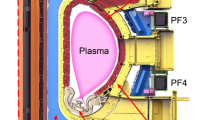Abstract
A fundamental revamping of magnetic plasma fusion research is needed, because the current focus of world fusion research—the ITER-tokamak concept—is virtually certain to be a commercial failure. Towards that end, a number of technological considerations are described, believed important to successful fusion research. Beyond critical attention to plasma physics challenges, there must be a much sharper focus on electric utility acceptance criteria, which strongly reflect the public interest. While the ITER-tokamak experience has provided important understanding of a variety of technology issues, it is expensive and time-consuming. Engineers with commercial-world experience must become involved in future fusion research and must have a major influence on program decision-making and evaluation. Fusion engineers will have to be imaginative while being rooted in an understanding of fission reactor development, nuclear regulation, and electric utility realities, the proper consideration of which will impact fusion program success. Properly developed, fusion power holds great promise as an attractive electric power source for the long-term future.

Similar content being viewed by others
Notes
Here we use the term magnetic confinement to differentiate from inertial fusion, which typically involves the very rapid compression of DT-containing pellets. Laser fusion is one example of inertial fusion.
Large in the context of neutron streaming/leakage is a relative term. In the case of a vacuum duct running through a one meter blanket, 10 cm diameter (10/100 ratio) might qualify as “large”.
Some researchers have suggested that a flowing lithium stream might be utilized as a viable dump for helium fusion products. That might be possible, but regulators and plant operators are sure to require extensive safety measures related to the use of liquid lithium, because of its associated fire and explosive hazards.
The cost of such a regulator-approved building cannot be estimated until a reactor design and adjacent maintenance and storage facilities are designed. However, as determined by Galambos, J.S. et al., The Impact of Advance Physics on Commercial Tokamak Fusion Reactors, November 4, 1993, the large size of ITER compared to a comparable fission reactor—over 150 times the volume—argues for an ITER-tokamak fusion power reactor building at least one, if not two orders of magnitude larger than a building to house a comparable fission reactor.
References
R.L. Hirsch, Fusion research: time to set a new path. Issues in Science and Technology. National Academies. Summer (2015)
J. Kaslow et al., Criteria for practical fusion power systems: Report from the EPRI fusion panel. J. Fusion Energ. 13(2/3), 181–182 (1994)
From “Nuclear Fusion.” Wikipedia: The Free Encyclopedia. Wikimedia Foundation, Inc., 30 Aug 2015. Web. Date accessed 30 Aug 2015. https://en.wikipedia.org/wiki/Nuclear_fusion: At least 0.1% of the reactions in a thermal p-11B plasma produce neutrons, primarily from the reaction 11B + α → 14 N + n + 157 keV. Another source of neutrons is the reaction 11B + p → 11C + n − 2.8 MeV. These neutrons will have energies comparable to the fuel temperature. While 11C is radioactive, it decays to negligible levels within several hours
W. Nevins, A review of confinement requirements for advanced fuels. J. Fusion Energ. 17, 25 (1998)
A. Najmabadi et al., The ARIES-AT advanced tokamak, advanced technology fusion power plant. Fusion Eng. Des. 80, 3–23 (2006)
L.M. Garrison, Improving the materials irradiation experimental facility and increasing understanding of helium irradiation of tungsten. Ph.D. Dissertation, 27 Aug 2013
L.M. Garrison, Kulcinski GL (2014) Irradiation resistance of grains near 001 on polycrystalline tungsten under 30 keV He + bombardment at 1173 K. Phys. Scr. T159, 014020 (2014)
D.P. Ivanov et al., Necessity of reliability enhancement for forced cooled superconducting magnet systems. вып. 1 Heoбxoдимocть пoвышeния нaдëжнocти cвepxпpoвoдящиx мaгнитныx cиcтeм (2012)
M. Claessons, Office of the director-general, ITER organization. Private communication. 19 Dec 2014
“Beta (plasma physics).” Wikipedia: The Free Encyclopedia. Wikimedia Foundation, Inc., 25 May 2015. Web. Date accessed 30 Aug 2015. https://en.wikipedia.org/wiki/Beta_(plasma_physics)
T.S. Taylor, Experimental achievement of toroidal beta beyond that predicted by “Troyan” scaling. GA-A21821. Sept 1994
T.S. Taylor, Exciting opportunities to advance fusion energy in magnetic confinement. Magnetic Fusion Concept Working Group. 1999 Fusion Summer Study, Snowmass Village, Colorado. 11–23 July 1999
D. Clery, Mystery company blazes a trail in fusion energy. Science. June 2, 2015
J. Park et al., High-energy electron confinement in a magnetic cusp configuration. Phys. Rev. X. June 11, 2015
E. Lerner et al., Theory and experimental program for p-B11 fusion with the dense plasma focus. J. Fusion. October 2011
U.S. Department of Energy. Accelerating low-cost plasma heating and assembly-alpha. ARPA-E.energy.gov. 12 May 2015
M.M. Waldrop, Plasma physics: the fusion upstarts. Nature. 23 July 2014
Author information
Authors and Affiliations
Corresponding author
Rights and permissions
About this article
Cite this article
Hirsch, R.L. Revamping Fusion Research. J Fusion Energ 35, 135–141 (2016). https://doi.org/10.1007/s10894-015-0053-y
Published:
Issue Date:
DOI: https://doi.org/10.1007/s10894-015-0053-y




